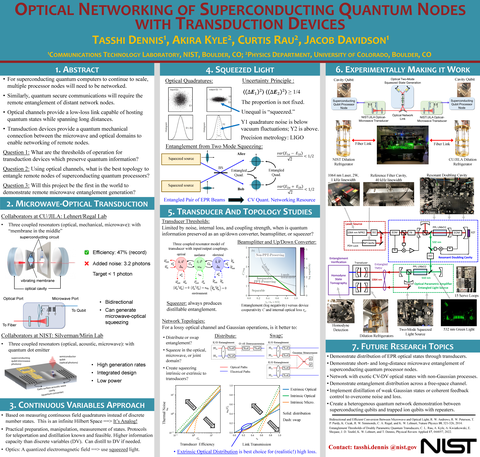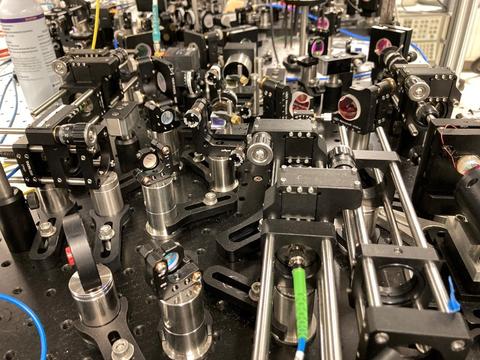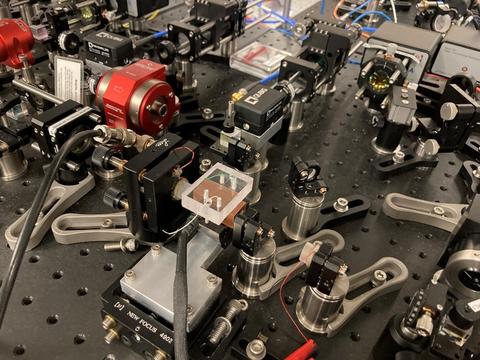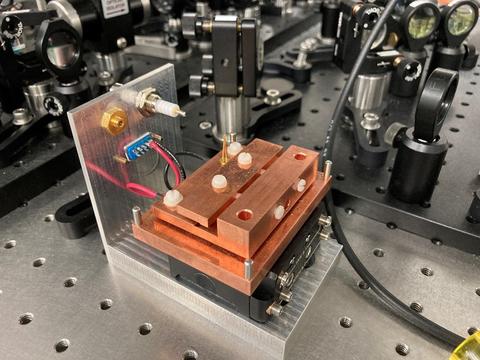Summary
A collaborative team working to establish the science and technology of networks for superconducting quantum computers by demonstrating the world’s first “Quantum Internet”.
View the Poster
Optical Networking of Superconducting Quantum Nodes with Transduction Devices

Description

The team is designing and constructing a quantum optical channel to create remote microwave entanglement for the networking of superconducting quantum computers, expected to be operational by the end of 2026.
In this primarily continuous variable approach, the entanglement distribution of optically generated two-mode squeezed states is being used as the quantum resource. At the network nodes, optical states are being down-converted to the microwave domain with doubly parametric, membrane-coupled resonator devices developed at NIST and CU-JILA with the world’s best available transduction performance. Implementation with continuous variables makes possible practical and efficient quantum state preparation, manipulation, and measurement with the potential to support on-demand, high-data rate applications. Alternatively, to combat the debilitating impact of loss on quantum signals, a single photon counting approach is being pursued.
Novel computers based on superconducting qubits have recently demonstrated quantum supremacy and represent one of the most promising technologies for future large-scale systems. Practical limits will soon require that optical networks be used to scale quantum computers by creating and maintaining remote microwave entanglement.
As well, quantum security is needed for critical communications in areas such as defense, commerce, and infrastructure. In our implementation, full security dictated by the laws of physics can be achieved by implementing quantum key distribution without assuming that the nodes must be trusted. Fundamental questions remain to be answered regarding what such a quantum network will look like and how it will operate.
The Quantum Networking Demonstration will:
• Test novel microwave-optical transducers being developed at NIST and CU-JILA
• Entangle and operate transducers as nodes of a network
• Develop networking protocols for continuous variables and single photons
• Establish practical limits for the measurement of fragile quantum states
• Support disparate networking node technologies
The Results of this Facility will Directly Impact:
• US leadership in quantum 2.0 technologies
• High-performance computing
• Secure communications
• Quantum metrology and sensors
• Quantum photonic sources and detectors
• Future quantum networking standards
• US global competitiveness
Literature References
• Entanglement Thresholds of Doubly Parametric Quantum Transducers, Curtis L. Rau, Akira Kyle, Alex Kwiatkowski, Ezad Shojaee, John D. Teufel, Konrad W. Lehnert, and Tasshi Dennis, Phys. Rev. Applied, Vol. 17, 044057, April 2022.
• Optically Distributing Remote Two-Node Microwave Entanglement Using Doubly Parametric Quantum Transducers, Akira Kyle, Curtis L. Rau, William D. Warfield, Alex Kwiatkowski, John D. Teufel, Konrad W. Lehnert, and Tasshi Dennis, Phys. Rev. Applied, Vol. 20, 014055, July 2023.



WANT TO BE INVOLVED?

This project is funded by the National Quantum Initiative, and NIST has numerous mechanisms for collaborating with the team on this project:
The NRC Postdoctoral Program
The NRC Research Associateship Program has opportunities available for research related to this project (eligibility requirements include US Citizenship). Application cycles are in January and August, and it is recommended that you contact us well in advance of this deadline.
The NIST PREP Program
The NIST Professional Research Experience Program (PREP) was created at NIST-Boulder in 1991 and is designed to provide valuable laboratory experience and financial assistance to undergraduates, graduate students, postdocs, and faculty. The program is intended to assure the continued growth and progress of a highly skilled science, technology, engineering, and math (STEM) workforce in the United States.
The NIST SURF Program
The NIST-Boulder Summer Undergraduate Research Fellowship (SURF) program provides summer research opportunities for undergraduate researchers during an 11-week program. Students work alongside NIST scientists and will have their own research projects to complete. Student applications are submitted in February.
Research Collaborations
Collaborations are available to US and international citizens as well as various government agencies.
If you are interested or have any questions, please contact the project leader, tasshi.dennis [at] nist.gov (Tasshi Dennis).

